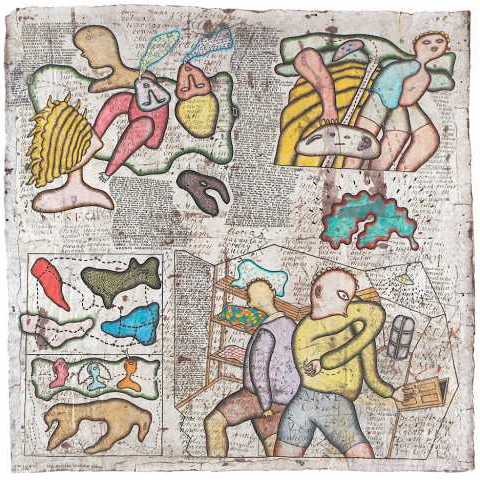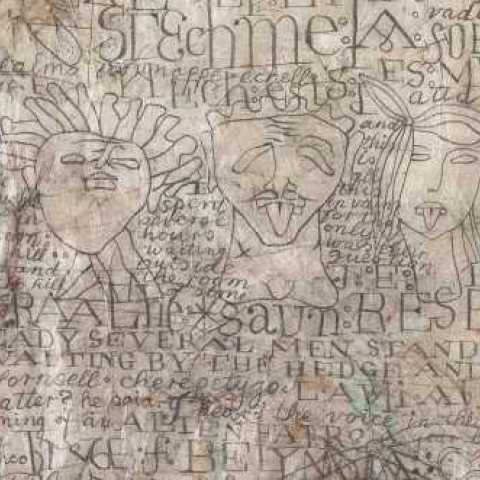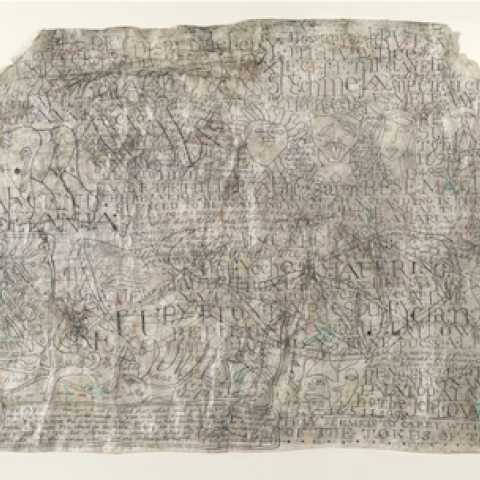Art First
15a Saint Mary's Walk
London
SE11 4UA
United Kingdom





This is the first tribute exhibition to Simon Lewty since he died in 2021 and it brings to light some of his most affecting, curious and brilliant works. The dream like imagery, with its flow of calligraphic words and the overall poetic output, is unlike any other artist’s. Following his major debut exhibition at the Serpentine Gallery, in 1985, his practice evolved privately, from home studios in Leamington Spa and through regular exhibitions with Art First in London. Various Art fairs and occasional exhibitions of work abroad, acquisitions and guest appearances in museums throughout the UK, brought him to the attention of others, especially artists, but he did not travel or ‘market’ himself, making only occasional appearances at exhibitions, attending his own openings and gallery dinners, but then rapidly retreating to the calm of his studio.
He leaves an extraordinary legacy. There are about 350 works, all on paper as this was his only medium and therefore all his works are drawings, rather than paintings, for it was the pencil and the pen, not the brush, that were his tools. We await the release of fifty hours of interview with Cathy Courtney for the ‘Artists’ Lives’ sound recordings in the British Library archive, which is shared with Tate. Lewty chose to keep his interview locked until after his death, so there will be revelations.
I had the great privilege of representing Simon Lewty for over 33 years, yet he guarded his secrets gently, disclosing only a few, with a twinkle in his eye. He read everything and loved working – it was his raison d’être. All his energies went into the harvesting of ideas, of words and phrases, of dream sequences captured in his notebooks, of the absurd, of handwriting of every kind. In his late years he even mastered tachygraphy, a Seventeenth Century shorthand used by Samuel Pepys (amongst many other civil servants during those turbulent times) in his famous diaries.
Naturally, Lewty attracted other writers and poets and was fortunate to have in them the greatest friends whose gift was to write about his work with deep understanding as well as the most beautiful turn of phrase. To his very last days he collaborated with his friend, the poet Peter Larkin, and in Paul Hills he had a fellow artist, an academic, a writer and leading art historian after his own heart. It is to Hills that I turn again and again to find the most illuminating passages. Here is a brief selection beginning with his ‘Notes towards a biography’ (1992).
“Reading music, particularly choral music, Lewty’s eye became attuned to the visual relationship between words and the sign-language of musical notation. In an interview in 1986, he will observe that, ‘a map is diagrammatic but it also functions as a surrogate for experience, in the way a score relates to musical performance.’”
“It was at Warwick School that Simon Lewty first went to a church service, and what seems to have struck him most was the declamatory and musical aspect. ‘I had to learn to chant the psalms’, he told me. It called to mind the many published statements in which he has spoken of the importance of the sound as well as the look of his texts, for indeed if we look and listen there is something almost psalm-like about their strange litanies.”
Hills writes about Lewty’s introduction of words into his drawings from the mid-seventies onwards, thinking about the messages, codes and meanings. “Lewty has described one of the functions of the writing as being to ‘draw you in closer’. The cursive script, often little larger than handwriting, is small in relation to the totality of the picture, so that the viewer is pulled inwards to read, then steps back again to take in the whole.”
Lewty developed his characteristic use of the palimpsest through the 1980’s. Runes and lists of neologisms appear, deliberate erosion and effacement echo the shifts of historic time, invented words and apparently arbitrary capitalisation acquire a concrete, diagrammatic presence. Lewty maps images and words across the surfaces, the word becomes image. There is an element of the misleading, but also of interiorisation of meaning (remember, Lewty loved secrets) and of course Lewty absorbed a great deal from Surrealism – from André Breton in particular, whose theory of automatic writing served Lewty throughout his life. William Blake and Paul Klee provided constant inspiration, and then there was the power of graffiti.
“A book of illustrations of medieval graffiti is one of Simon Lewty’s prize possessions” writes Paul Hills. “Through every age graffiti challenge the polite, the logical, the refined. They are carved and daubed by invisible hands, yet they testify to past inhabitants. Above all they offer the relief of utterance. David Stoker contemplating Lewty’s neologisms ventured, cheekily, that ‘one can’t help but entertain the possibility that embedded somewhere in these lists is the Albanian for “Bugger off!”.
At the turn of the millennium Lewty abandoned imagery, widening instead his exploration of scripts in many different hands, including his beautiful abstract scripts, which in 2019 became what he called ‘pencillings’. One of the last set of images he did make use of were his own drawings, made as a child aged 4 – 7, in the inside covers and fly leaves of the nine volumes of ‘The New Book of Knowledge’ (a junior encyclopedia). “The imagery was so strange and fresh, and yet obscure in much of its intent, that is had all the impact of ‘found’, and I knew immediately that I wanted to re-engage with it – to work with my child-self as a collaborator.” The resulting drawings, charged with new mental energies, were shown in his 2004 exhibition Eclipses.
Four years later Lewty wrote his own catalogue essay for his powerful exhibition, The Self as a Stranger. He created some of his biggest works since the 1980’s, but these were all what he described as ‘fields of texts’, written in soft pencil.
“Now the words on the wall seem to rise and fall, as though breathing. As I look more closely, phrases begin to emerge. Mimicking the rhythms and patterns of speech, they wander and drift. They appeal, they suggest, they insist, they hesitate, they contradict each other and themselves, they exclaim, they cajole, they question, they point, they rejoice, they sigh. They hint at many stories, but tell none. This text is writing me, not I the text…….”
Such were his findings here that he took the same title for the book, the first extensive monograph, published in 2010 by Black Dog Publishing, Simon Lewty: The Self as a Stranger. I had the great pleasure of editing the book, drawing together already published essays by distinguished writers from exhibition catalogues along the way. These include Paul Hills, Peter Larkin, Jessica Dubow, Cathy Courtney, Susan Michie, Simon Lewty himself and a previously unpublished essay by the late Stuart Morgan, written for the 1985 exhibition at the Serpentine Gallery. A new voice was introduced, that of poet and writer Ian Hunt, who wrote the sensitive foreword with its fresh considerations about the surface in Lewty’s work, how it acts as an extremely subtle formal basis for thinking about how his work both is and is not, to be understood as writing:
“The surface is changed by the process of inscription but is never reducible to the meaning of the words written on it: it seems to come before and after the words and makes a complex and mostly unconscious or unverbalised impression on the viewer’s reception of what the work gives.”
For the publication accompanying Simon Lewty’s 2016 survey exhibition, The SIGNificance of Writing, at the Leamington Spa, Art Gallery & Museum, (his home-town), Ian Hunt’s luminous essay ends thus: “The singularity of Lewty’s aesthetic thinking is as prominent in the work of the last twenty years, which is rightly emphasized by this selection, as it was in the first works by him that came to be widely exhibited in the 1980s. This is work that is not simply humming to itself but which also, without warning, SINGS.”
Lewty’s work is held in museum collections including The British Museum, the Victoria & Albert Museum, the Arts Council of England, the museums and art galleries of Birmingham, Wolverhampton, Worcester, Leamington-Spa, Stoke-on Trent, Leeds, Preston, , and in the USA, the Sackner Archive of Visual and Concrete Poetry, University of Iowa Libraries
For further information and images, please contact Clare Cooper: [email protected] and visit the Simon Lewty section of the gallery website: www.artfirst.co.uk
Gallery hours are Wed – Fri 11 – 6 or at other times by appointment.
